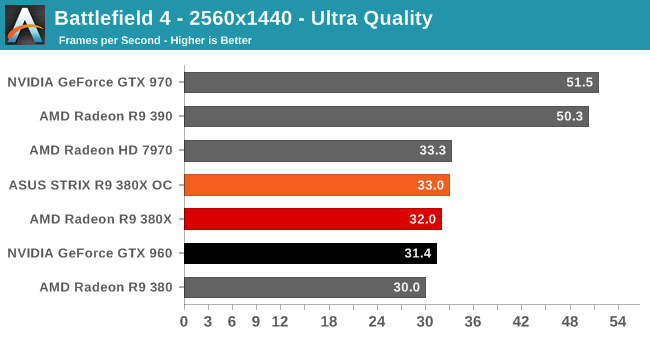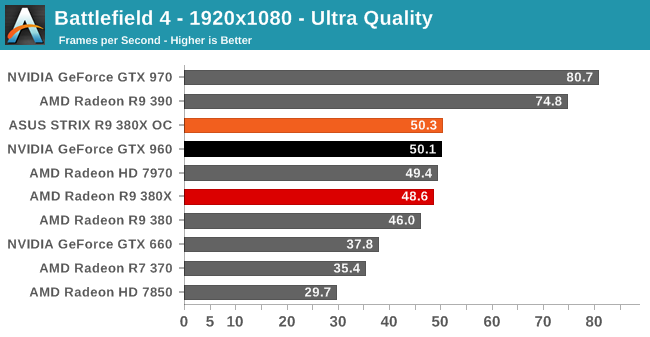The AMD Radeon R9 380X Review, Feat. ASUS STRIX
by Ryan Smith on November 23, 2015 8:30 AM EST- Posted in
- GPUs
- AMD
- Radeon
- Asus
- Radeon 300
Battlefield 4
Kicking off our benchmark suite is Battlefield 4, DICE’s 2013 multiplayer military shooter. After a rocky start, Battlefield 4 has since become a challenging game in its own right and a showcase title for low-level graphics APIs. As these benchmarks are from single player mode, based on our experiences our rule of thumb here is that multiplayer framerates will dip to half our single player framerates, which means a card needs to be able to average at least 60fps if it’s to be able to hold up in multiplayer.


Though not doing poorly, Battlefield 4 has not been a game AMD’s products have excelled at lately. Case in point, at 1080p even the referenced clocked R9 380X can’t unseat the GeForce GTX 960; it takes the ASUS factory overclock to do that. Overall while the 380X is on average 10% faster than the GTX 960, as we’ll see as we work through our games it will not take the top spot in every single game, so this will not be a clean sweep.
Meanwhile Battlefield 4 is a good example of why AMD wishes to focus on 1440p, despite the fact that Tonga is going to come up a bit short in overall performance. As we’ve seen time and time again, AMD’s performance hit with resolution increases is less than NVIDIA’s, so a loss for the R9 380X at 1080p is a win at 1440p. There are a few cases where the R9 380X is fast enough for 1440p, but by and large you’d have to take a quality hit to reach the necessary performance. So unfortunately for AMD this bulk of the focus on the R9 380X is going to be at 1080p.
As for comparisons with past cards, we’ve gone ahead and thrown in the Radeon HD 7850 and the GeForce GTX 660, 2GB cards that launched at $249 and $229 respectively in 2012. Part of AMD’s marketing focus for the R9 380X will be as an upgrade for early 28nm cards, where the R9 380X is a significant step up. Between the greater shader/ROP throughput, greater memory bandwidth, and doubled memory, the R9 380X is around 82% faster than the 7850, which traditionally is around the area where a lot of gamers look for an upgrade.
Finally, at the other end of the spectrum, it’s worth pointing out just how far ahead of the R9 380X the R9 390 and GTX 970 are. In the introduction we called them spoilers, and this is exactly why. They cost more, but the performance advantage of the next step up is quite significant.










101 Comments
View All Comments
Asomething - Tuesday, November 24, 2015 - link
The HSA foundation is partially founded by ARM which means they are already working on it (but as you said there isnt much motivation to make HSA enabled apps). AMD is the only high profile and headline grabbing member of it so they tend to get the most press because of clickbait articles. And a lot (if not all) of nvidia's efficiency improvements do come from the lower transistor density (also the main reason they can say their TDP is so low since the chip has a larger surface area with which to dissipate the same amount of heat as the same chip made using AMD's high density libraries would have), improvements to the memory and reductions in DP capabilities.tamalero - Tuesday, November 24, 2015 - link
anyone can explain me why everyone says the new gpus are overpriced?their pricepoints seems to be similar to the performance of the nvidia cards.
the table on the first page shows clearly.
Even the review shows the 970 and the AMD 390 trading blows and have the same price point.
so, what did I miss? why suddenly fanboys demand even 15% reduction to "become competitive" ?
FriendlyUser - Tuesday, November 24, 2015 - link
As everyone has noted, the cards are uncomfortably close to the higher tier (390 and 970). So, the 380X is not overpriced with respect to the competition from nvidia, but with respect to the 390. The jump in performance is so great, that we should either hope the 390 goes at $300 (practically eliminating the 380X) or the 380X completely dominates the sub-200 territory.Anyway, overall it's a very good product.
just4U - Friday, November 27, 2015 - link
Well.. here in Canada that's not quite the case. A 380/960 /w 4G mem sells for 300ish.. the 380X $330.A 970 runs you $450-500 and a 390 $430+ No way their priced similar to the 970/390.
BurntMyBacon - Tuesday, November 24, 2015 - link
@Samus: "They need to drop the prices across the entire line about 15% just to become competitive."That wouldn't fix the biggest pricing problem shown in this review. The 380X is priced too closely to the 390 given the performance difference. Drop them both by 15% and the 380X is still priced too closely to the 390. I'll leave the rest of you to argue performance vs premium cooler value on the high end and 390/390X vs GTX970/GTX980 performance per dollar, but I submit that a flat 15% drop is too simple an answer to the problem due to competition within their own lineup.
Azix - Wednesday, January 13, 2016 - link
but people were fine with the 960 at the same price...zeeBomb - Monday, November 23, 2015 - link
Ryan smith blessed us with a great graphics card review.maecenas - Monday, November 23, 2015 - link
At this point, NVIDIA or AMD, I'm not sure I would get anything other than an ASUS cooling system. I have the STRIX version of the GTX 970 and it really is fantastic.jasonelmore - Monday, November 23, 2015 - link
It Depends on what you need. The Stock Blower Coolers keep hot air out of the case, so for Small Form Factor Builds, your not going to want Asus's coolers since they dump the hot air back into the case.theduckofdeath - Tuesday, December 1, 2015 - link
I have a mATX case with water cooling and internal padding all around to keep the noise down, and my ASUS Strix GTX 960 is not making a sound and the temp in the case does not go above 50-52 degrees celsius even after hours of playing. The problem with GPUs sucking air out from the rear and blowing the same air out is, they have to generate all of the airflow themselves, which always gets really noisy compared to using the air passing through a case.